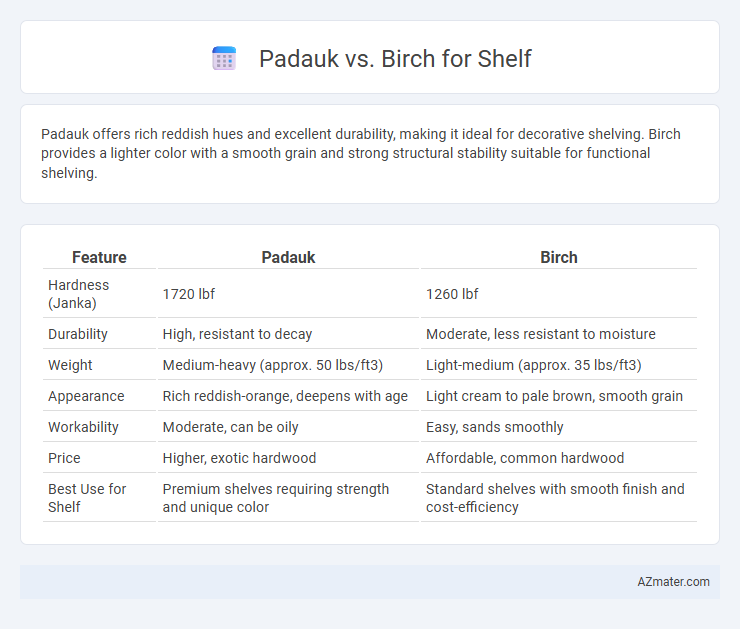Padauk offers rich reddish hues and excellent durability, making it ideal for decorative shelving. Birch provides a lighter color with a smooth grain and strong structural stability suitable for functional shelving.
Table of Comparison
| Feature | Padauk | Birch |
|---|---|---|
| Hardness (Janka) | 1720 lbf | 1260 lbf |
| Durability | High, resistant to decay | Moderate, less resistant to moisture |
| Weight | Medium-heavy (approx. 50 lbs/ft3) | Light-medium (approx. 35 lbs/ft3) |
| Appearance | Rich reddish-orange, deepens with age | Light cream to pale brown, smooth grain |
| Workability | Moderate, can be oily | Easy, sands smoothly |
| Price | Higher, exotic hardwood | Affordable, common hardwood |
| Best Use for Shelf | Premium shelves requiring strength and unique color | Standard shelves with smooth finish and cost-efficiency |
Introduction to Padauk and Birch Wood
Padauk wood, known for its vibrant reddish-orange hue and natural durability, offers excellent resistance to decay and insect attacks, making it ideal for sturdy, long-lasting shelves. Birch wood features a pale yellow color with a smooth, fine grain pattern that provides a clean, modern appearance, favored for its strength and ease of finishing. Both woods derive from hardwood species, but Padauk typically boasts greater hardness and dimensional stability, while Birch stands out for its affordability and consistent texture.
Key Characteristics of Padauk
Padauk wood is valued for its striking reddish-orange hue, exceptional durability, and natural resistance to decay and insects, making it ideal for sturdy and long-lasting shelves. Its coarse, open grain provides a visually appealing texture while maintaining a smooth finish after sanding, which complements both modern and rustic interior designs. Padauk also exhibits excellent stability with minimal warping or shrinking, ensuring shelves retain their shape and strength under varying environmental conditions.
Key Characteristics of Birch
Birch wood is known for its fine, even grain and pale color, making it a versatile choice for shelves that need a clean, modern aesthetic. It is moderately hard and durable, providing good resistance to wear and impact while maintaining ease of machining and finishing. Birch's consistent texture and strength make it ideal for shelves intended to hold moderate weight without warping or sagging over time.
Strength and Durability Comparison
Padauk offers exceptional strength with a Janka hardness rating of approximately 1725, making it highly resistant to dents and scratches, while birch has a lower hardness rating around 1260, making it less durable under heavy loads. Padauk's dense, oily wood fibers provide superior durability and resistance to wear, ideal for shelves meant to hold heavy items or endure frequent use. Birch's finer grain and lower density result in less resistance to impact and moisture, which can affect shelf longevity over time.
Aesthetic and Color Differences
Padauk shelves showcase a rich, reddish-orange hue that deepens to a warm brown over time, offering a bold and vibrant aesthetic ideal for statement pieces. Birch shelves feature a pale, creamy color with subtle grain patterns, imparting a light, neutral look that complements minimalist and Scandinavian interior designs. The contrast between Padauk's vivid tones and Birch's understated palette allows for distinct visual impacts depending on the desired room ambiance.
Workability and Ease of Construction
Padauk offers excellent workability due to its straight grain and smooth texture, making it easy to plane, sand, and finish, which is ideal for detailed shelf construction. Birch features a fine, even grain that also ensures ease of cutting and sanding, but it can be harder on tools compared to Padauk because of its density. Both woods allow for precise joinery, though Padauk's natural oils can sometimes interfere with gluing and finishing, requiring additional surface preparation.
Cost and Availability
Padauk wood typically costs more than birch due to its exotic origin and limited supply, making it less readily available in standard lumber markets. Birch is widely accessible and more affordable, commonly found in local hardware stores and lumberyards, which makes it a practical choice for budget-conscious shelf projects. The higher price and scarcity of Padauk may justify its use only when durability and striking reddish hues are prioritized over cost.
Maintenance and Longevity
Padauk offers superior resistance to moisture and pests, making it a low-maintenance choice for shelving that retains its vibrant reddish-orange hue over time. Birch, while more affordable and widely available, requires regular sealing or finishing to protect against moisture damage and wear, which may increase upkeep efforts. In terms of longevity, Padauk's dense and durable hardwood structure outlasts birch, ensuring a longer lifespan with less frequent refinishing.
Best Applications for Padauk Shelves
Padauk wood, prized for its vibrant reddish-orange hue and natural durability, excels in shelf applications requiring both aesthetics and strength, such as display shelving and statement furniture pieces. Its dense grain and resistance to decay make it ideal for use in humid environments like kitchens or bathrooms where Birch may warp or weaken. Padauk's ability to hold finish well ensures a lasting, rich appearance that enhances visual appeal in upscale interior design settings.
Best Applications for Birch Shelves
Birch shelves excel in indoor applications requiring a smooth, light-colored finish, making them ideal for modern, Scandinavian-style interiors and lightweight storage solutions. Their fine grain and durability suit decorative shelving, bookcases, and retail displays where aesthetics and moderate strength are essential. Birch's ease of staining also allows customization to match various decor themes, enhancing versatility in residential and commercial settings.

Infographic: Padauk vs Birch for Shelf
 azmater.com
azmater.com